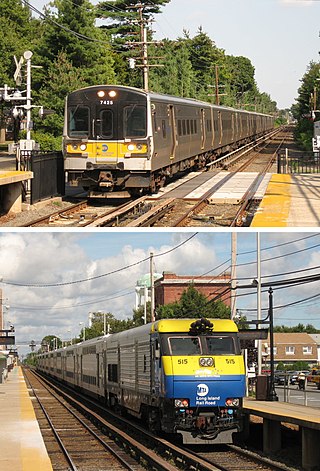
The Long Island Rail Road, often abbreviated as the LIRR, is a railroad in the southeastern part of the U.S. state of New York, stretching from Manhattan to the eastern tip of Suffolk County on Long Island. The railroad currently operates a public commuter rail service, with its freight operations contracted to the New York and Atlantic Railway. With an average weekday ridership of 354,800 passengers in 2016, it is the busiest commuter railroad in North America. It is also one of the world's few commuter systems that runs 24/7 year-round. It is publicly owned by the Metropolitan Transportation Authority, which refers to it as MTA Long Island Rail Road. In 2023, the system had a ridership of 75,186,900, or about 253,800 per weekday as of the fourth quarter of 2023.

The Jamaica station is a major train station of the Long Island Rail Road located in Jamaica, Queens, New York City. With weekday ridership exceeding 200,000 passengers, it is the largest transit hub on Long Island, the fourth-busiest rail station in North America, and the second-busiest station that exclusively serves commuter traffic. It is the third-busiest rail hub in the New York area, behind Penn Station and Grand Central Terminal. Over 1,000 trains pass through each day, the fourth-most in the New York area behind Penn Station, Grand Central Terminal, and Secaucus Junction.
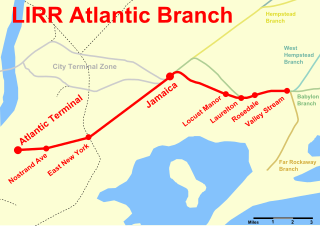
The Atlantic Branch is an electrified rail line owned and operated by the Long Island Rail Road in the U.S. state of New York. It is the only LIRR line with revenue passenger service in the borough of Brooklyn.

Copiague is a station on the Babylon Branch of the Long Island Rail Road, located in Copiague, New York. The station is located on Marconi Boulevard and Great Neck Road, one block north of Oak Street.

The Port Jefferson Branch is a rail line and service owned and operated by the Long Island Rail Road in the U.S. state of New York. The branch splits from the Main Line just east of Hicksville and runs northeast and east to Port Jefferson. Several stations on the Main Line west of Hicksville are served primarily by trains bound to/from the Port Jefferson branch, so LIRR maps and schedules for the public include that part of the Main Line in the "Port Jefferson Branch" service.

Hicksville is a station on the Main Line and Port Jefferson Branch of the Long Island Rail Road located in Hicksville, New York. It is the busiest station east of Jamaica and Penn Station by combined weekday/weekend ridership.

The City Terminal Zone is the set of Long Island Rail Road lines within New York City west of Jamaica station, except the Port Washington Branch.

The Babylon Branch is a rail service operated by the Long Island Rail Road in the U.S. state of New York. The term refers to the trains serving Montauk Branch stations from Valley Stream east to Babylon; in other words, the Babylon Branch is a rail service rather than an actual track. The electrification of the Montauk Branch ends east of the Babylon station, so the Babylon Branch is mostly served by electric trains.

The Montauk Branch is a rail line owned and operated by the Long Island Rail Road in the U.S. state of New York. The line runs the length of Long Island, 115 miles (185 km) from Long Island City to Montauk. However, in LIRR maps and schedules for public use, the term Montauk Branch refers to the line east of Babylon; service from Jamaica to Babylon is covered by separate Babylon Branch schedules, while the line west of Jamaica is currently unused for passenger service. A select number of Montauk Branch trains operate via the Main Line during peak hours.

The Ronkonkoma Branch is a rail service operated by the Long Island Rail Road (LIRR) in the U.S. state of New York. On LIRR maps and printed schedules, the "Ronkonkoma Branch" includes trains running along the railroad's Main Line from Hicksville to Ronkonkoma, and between Ronkonkoma and the Main Line's eastern terminus at Greenport. The section of the Main Line east of Ronkonkoma is not electrified and is referred to as the Greenport Branch.
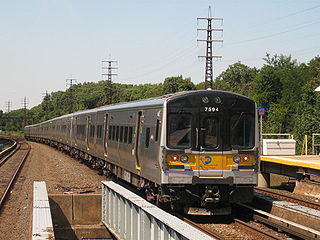
The Long Beach Branch is an electrified rail line and service owned and operated by the Long Island Rail Road in the U.S. state of New York. The branch begins at Valley Interlocking, just east of Valley Stream station, where it merges with the Far Rockaway Branch to continue west as the Atlantic Branch. East from there the Long Beach Branch parallels the Montauk Branch to Lynbrook station, where it turns south toward Long Beach station. Trains operating on the Long Beach Branch continue west of Valley Stream via the Atlantic Branch to Jamaica station, with most continuing on to Grand Central or Penn Station in Midtown Manhattan. In 2018, the branch recorded an annual ridership of 4,849,085 based on ticket sales, down 1% from 2017.

The West Hempstead Branch is an electrified rail line owned and operated by the Long Island Rail Road (LIRR). It runs between Valley Stream and West Hempstead, in Nassau County, New York, United States.

The Hempstead Branch is an electrified rail line and service owned and operated by the Long Island Rail Road in the U.S. state of New York. The branch begins at the Main Line at Queens Interlocking, just east of Queens Village station. It parallels the Main Line past Bellerose to Floral Park, where it splits southward and continues east via the village of Garden City to Hempstead Crossing. There it turns south to the final two stations, Country Life Press and Hempstead.
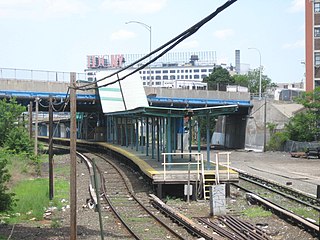
The Hunterspoint Avenue station is a station on the Main Line of the Long Island Rail Road within the City Terminal Zone. It is located at 49th Avenue between 21st Street and Skillman Avenue in the Hunters Point and Long Island City neighborhoods of Queens, New York City. This ground-level station has an island platform between two tracks and is currently not wheelchair accessible from the entrance above the station.
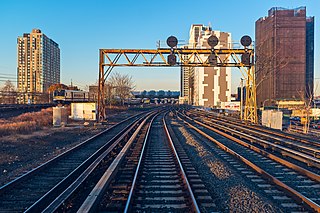
The Main Line is a rail line owned and operated by the Long Island Rail Road in the U.S. state of New York. It begins as a two-track line at Long Island City station in Long Island City, Queens, and runs along the middle of Long Island about 95 miles (153 km) to Greenport station in Greenport, Suffolk County. At Harold Interlocking approximately one mile east of Long Island City, the tracks from the East River Tunnels and 63rd Street Tunnel into Manhattan intersect with the Main Line, which most trains use rather than using the Long Island City station.
The Long Island Rail Road is a railroad owned by the Metropolitan Transportation Authority in the U.S. state of New York. It is the oldest United States railroad still operating under its original name and charter. It consolidated several other companies in the late 19th century. The Pennsylvania Railroad owned the Long Island Rail Road for the majority of the 20th century and sold it to the State in 1966.

Hollis is a station on the Long Island Rail Road's Main Line at the intersection of 193rd Street and Woodhull Avenue in the Hollis neighborhood of Queens, New York City. With a few exceptions, only trains on the Hempstead Branch stop here.
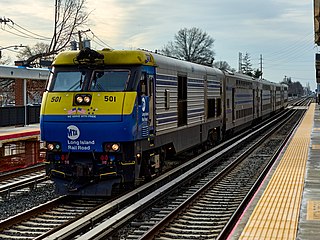
The EMD DE30AC and DM30AC are a class of 46 locomotives built between 1997–1999 by Electro-Motive Division in the Super Steel Plant in Schenectady, New York, for the Long Island Rail Road of the Metropolitan Transportation Authority (MTA) in New York. Originally divided equally between the two types, the fleet currently consists of 24 DE30AC locomotives and 20 DM30AC locomotives.
Higbie Avenue was a railroad station along the Atlantic Branch of the Long Island Rail Road, in Queens, New York City. The station was located on 140th Avenue and Edgewood Avenue in the Springfield section of Queens, New York City between Locust Manor and Laurelton stations.


























